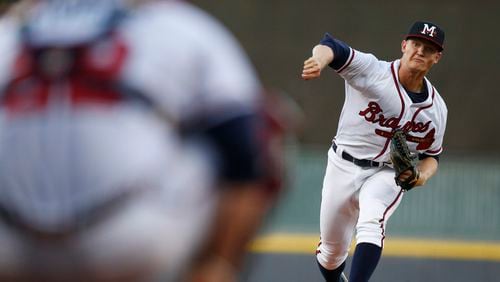A year before the Cubs became the envy of baseball, the Mets were the envy of baseball. They made the World Series, which is always nice, and they made it with a rotation stocked with young pitchers who seemed capable of making the Mets an October staple.
The Mets’ starting pitchers in the 2015 postseason were Matt Harvey, then 26; Jacob deGrom, 26; Steven Matz, 24; and Noah Syndergaard, 23. Bartolo Colon, the 42-year-old who won 14 games and logged 194 2/3 innings that season, worked only as a reliever. In the NLCS, the Mets swept the aforementioned Cubs, who were loaded with young hitters. Stop me if you’ve heard this before, but good pitching stops good hitting.
In the fall of 2015, almost every MLB club would have traded its rotation for the Mets’ young arms. Nineteen months later, only one of those arms is hale. Harvey underwent rib-removal surgery last July; his ERA this season is 5.14, his strikeouts-per-nine-innings rate down from 10.6 his rookie year to 5.1 Matz is on the disabled list with a strained flexor tendon and hasn’t pitched this season. DeGrom appears OK after being shut down in September last season with forearm tightness. As for Syndergaard …
The hardest-throwing starter in baseball — he’s known as Thor — contrived to gain 17 pounds over the winter, the aim being to throw harder. (Note that Syndergaard has delivered his slider, which is a breaking pitch, at 95 mph.) Because Thor’s hammer of an arm is such a prized commodity, his every twinge sends a shudder through the Mets’ front office, which made it odd that he declined, after skipping a start because of biceps tenderness, to have an MRI last week.
Odder still: The Mets didn’t insist on it. Said general manager Sandy Alderson: “I can’t tie him down and throw him in the tube.”
Last Sunday, the god of thunder exited after two innings. He was placed on the disabled list Monday with a torn lat. Rough estimates suggest he could miss three months. Will Carroll, who has written extensively on baseball injuries, tweeted: “So this Syndergaard thing — simple, kinetic chain problem. He added force to already questionable mechanics. What did you expect?”
Thus did the week begin with the Mets, sans Thor, arriving at SunTrust Park and Alderson responding to charges that his team had failed to protect its pitchers, which is a damning charge when you’ve built around pitching. (Zack Wheeler, the 26-year-old Smyrna native whose Thursday start was truncated by rain, is coming off two missed seasons after Tommy John surgery.) Across the way, a team betting its future on young pitching watched with keen interest.
Citing professional courtesy, Braves GM John Coppolella wouldn’t comment directly on the Mets. But he did, when asked if seeing another team struggle to keep young arms healthy gave him cold chills, offer this: “There are a lot of injuries in baseball. We do our best to try to prevent them, but to think we’re never going to have an injury, we’d be kidding ourselves.”
Which isn’t to say the Braves aren’t trying. They’ve added minor-league pitching instructors, the esteemed Dom Chiti chief among them. They fired pitching coach Roger McDowell, who infamously saw Kris Medlen and Brandon Beachy each have two rounds of Tommy John and whose relationship with some younger pitchers had turned adversarial. Like every team, they track the innings worked by every arm in their system. Like every team, they cross their fingers.
One way the Braves are unlike the Mets: Their younger guys don’t throw as hard as Syndergaard. There’s thought among baseball observers that throwing 99 mph is injurious to long-term health. In his newsletter this week, Joe Sheehan identified the 12 hardest-throwing starters of the past 15 years. His finding: “The 11 behind Syndergaard have combined for seven Tommy John surgeries.” Harvey was among that number.
Kolby Allard, the Braves’ No. 1 draftee in 2016, throws in the 89-92 mph range. Mike Soroka, that year’s No. 2 pick, sits at 89-94. At 19, Allard and Soroka are the youngest players in Double-A. This isn’t to say the Braves don’t like velocity: Team president John Hart raves about Luiz Gohara, plucked from Seattle for Mallex Smith, hitting 99 mph in Single-A. Still, if any franchise knows that the radar gun isn’t all, it’s the one that employed Tom Glavine and Greg Maddux.
Another difference: The Braves haven’t yet faced the issue of what happens with young pitchers in October. The 2015 postseason heaped 80 2/3 high-stress innings and 14 starts atop the collective workloads of Syndergaard, Harvey, deGrom and Matz, all of whom have since suffered some manner of physical issue. To be fair, there’s no proven way of finessing a playoff run. After the Nationals had Stephen Strasburg skip the 2012 postseason, he did five DL stints over the next four seasons. Now 28, he has worked 200 innings in a season once.
So: Can caution become counterproductive? Of the Braves, Sheehan wrote last month: “The Braves may be the canary in the coal mine. Their rebuild has been around young starters. It’s just so hard to thread the needle. Teams are so concerned about workloads — excessively, I would now argue — that they don’t get as much value from their young pitchers as they might … Unless a team is going to put its young starters in the rotation and pitch them, it may not be possible to get enough value from that kind of approach to make it sensible.”
Coppolella: “You try to protect your pitchers, but it’s a Catch-22. If you let them work a lot of innings, you risk them getting hurt. If you don’t, you risk them not developing.”
So what’s the answer? According to Coppolella, it lies in weight of numbers. “The best protection is top-shelf pitching depth,” he said. “We just keep taking pitchers, trading for pitchers, developing pitchers. We spent money for (big-league starting) pitching this year, but we didn’t give up any pitching depth.”
Here he voiced the line that has become the Braves’ boilerplate, generally ascribed to the famed scout Paul Snyder: “He used to say it takes 10 (pitchers) to get two.” In an industry where success hinges on tender arms, the only possible inoculation is volume.
About the Author







